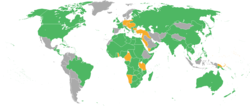Central powers
| Central Powers | |||||
|
Mittelmächte (German) Központi hatalmak (Hungarian) İttifak Devletleri (Turkish) Централни сили (Bulgarian) |
|||||
| Military alliance | |||||
|
|||||
|
|||||
| Capital | |||||
| Political structure | Military alliance | ||||
| Historical era | World War I | ||||
| • |
Dual Alliance (Germany / Austria-Hungary) |
7 October 1879 | |||
| • | Established | 28 June 1914 | |||
| • | Ottoman–German Alliance | 2 August 1914 | |||
| • | Bulgaria–Germany treaty |
|
|||
| • | Dissolved | 11 November 1918 | |||
The Central Powers (German: Mittelmächte; Hungarian: Központi hatalmak; Turkish: İttifak Devletleri or Bağlaşma Devletleri; Bulgarian: Централни сили Tsentralni sili), consisting of Germany, Austria-Hungary, the Ottoman Empire and Bulgaria – hence also known as the Quadruple Alliance (German: Vierbund) – was one of the two main factions during World War I (1914–18). It faced and was defeated by the Allied Powers that had formed around the Triple Entente, after which it was dissolved.
The Powers' origin was the alliance of Germany and Austria-Hungary in 1879. The Ottoman Empire and Bulgaria did not join until after World War I had begun.
The Central Powers consisted of the German Empire and the Austro-Hungarian Empire at the beginning of the war. The Ottoman Empire joined the Central Powers later in 1914. In 1915, the Kingdom of Bulgaria joined the alliance. The name "Central Powers" is derived from the location of these countries; all four (including the other groups that supported them except for Finland and Lithuania) were located between the Russian Empire in the east and France and the United Kingdom in the west. Finland, Azerbaijan, and Lithuania joined them in 1918 before the war ended and after the Russian Empire collapsed.
...
Wikipedia

